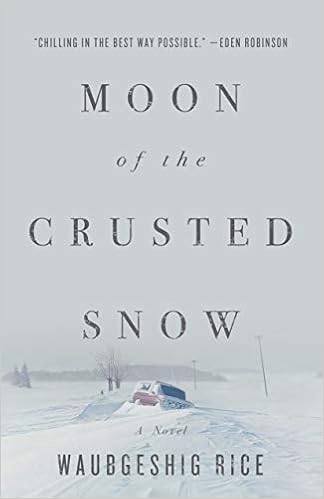In a small, remote Anishinaabe community, winter is about to begin when, one by one, all communication and power grids are lost. Initially there is no great worry because outages are common; however, as time passes, anxiety rises, especially when the community learns about society collapsing in the outside world. The food supply becomes a major concern, and panic starts to build. When a white man arrives, he changes the dynamics: power struggles begin. Will the people be able to survive the long winter?
Most of the novel is narrated from the perspective of Evan Whitesky, a thoughtful
young man who is skilled in the traditional Anishinaabe way of life; in the
opening scene, he is hunting to provide food for his family. Evan is the one fully developed
character. He is a man of integrity. His major concern is the welfare of his
family, but he also tries to help maintain order in the community and ensure
that vulnerable people receive basic needs.
Though he has many positive qualities, he is not perfect: though he understands the negative impact
alcohol has had on his people, he drinks even knowing he will inevitably
experience “his usual conflicted morning-after emotions of guilt and defiance.”
Development of other characters is missing. There is little differentiation so it’s easy
to think of the one-dimensional characters only in terms of labels like the
best friend, the co-worker, and the well-intentioned leader. Some development of Justin Scott would have
been useful because his motives remain unknown.
Why does he choose to be a disruptor?
Is he just supposed to be a representative of the evil white man who has
interfered and brought violence and destruction to Indigenous peoples?
Some characters are just dropped into the narrative without
explanation. For example, a man named
Dave Meegis shows up in Chapter 15 and pores over “invoices, charts, and
documents about energy consumption.” Who
is he? Is he a band councillor? All we know is that, given his surname, he
must be related to the chief. Later in
Chapter 21, a sentence begins with “The woman screamed . . . ” but there has
been no previous mention of a woman being present.
There is a great deal of exposition in the book so I often had the
impression that the author was more concerned with showcasing Anishinaabe
culture and criticizing colonialism than with creating a work of fiction with
literary qualities. For example, “As he
took from the earth, he gave back. It
was the Anishinaabe way, as he understood it” and “he planned to give a lot of
the meat away. It was the community way”
and “hunting, fishing, and living on the land was Anishinaabe custom.” The ritual of smudging is explained as “an integral
part of Anishinaabe spirituality. It
represented a cleansing of the spirit, and the ceremony was believed to clear
the air of negativity.” Then the author
feels compelled to give some history: “This
protocol had once been forbidden, outlawed by the government and shunned by the
church. When the ancestors of these Anishinaabe
people were forced to settle in this unfamiliar land, distant from their
traditional home near the Great Lakes, their culture withered under the pressure
of the incomers’ Christianity. The white
authorities displaced them far to the north to make way for towns and cities.” Of course, I understand the need to explain
this culture and history to non-Indigenous readers who might have little
knowledge of either.
There is too much telling and not enough showing. For instance, the power struggles, a main
conflict in the second part of the novel, are not directly shown. We are told that Jordan Scott causes
divisiveness but we are not shown how he does so. How can someone convince people to violate a strong
moral code? Suspense is certainly
diminished because we hear about events instead of see events.
The theme of the novel is that Indigenous people have been in survival
mode since the arrival of whites and they will continue to survive if they live
according to their traditional ways. An
elder points out, “’Our world isn’t ending.
It already ended. It ended when
the Zhaagnaash come into our original home down south on that bay and took it
from us. That was our world. When the Zhaagnaash cut down all the trees
and fished all the fish and forced us out of there, that’s when our world
ended. . . . But then they followed us up here and started taking our children
away from us! That’s when our world
ended again. And that wasn’t the last
time.’” Those like Evan’s brother who
have adopted white values and become too reliant on the ways of the whites have
the most difficulty trying to survive, whereas those like Evan who live off the
land by hunting, fishing, and trapping, and work together in “the Anishinaabe
spirit of community” are more successful.
“The collapse of the white man’s modern systems” may in fact lead to a
rebirth of “new life nestled deep in the heart of Anishinaabe.”
In many ways, this book reads like Young Adult fiction. It is written in a straightforward style with
unadorned prose. It is informative about
First Nations culture and history which Canadians, especially the youth, need
to learn about. The novel is not of
exceptional literary quality but it is worth reading because it provides a new
perspective.

Perfect review. I feel this way but haven't but able to put it into words as well as this. The pace of the novel felt so strange, and for how slow the book goes for most of it, I don't understand why hardly anything was actually explained.
ReplyDelete